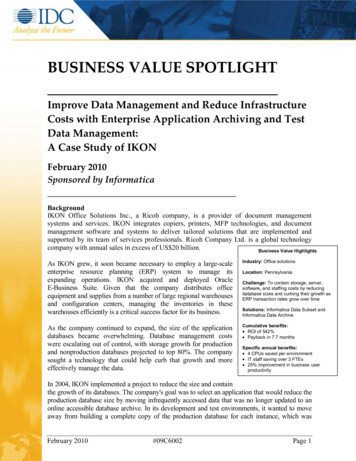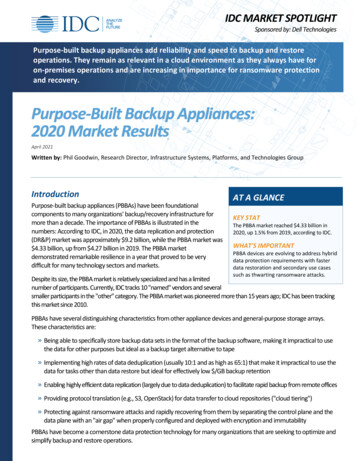
Transcription
BUSINESS VALUE SPOTLIGHTImprove Data Management and Reduce InfrastructureCosts with Enterprise Application Archiving and TestData Management:A Case Study of IKONFebruary 2010Sponsored by InformaticaBackgroundIKON Office Solutions Inc., a Ricoh company, is a provider of document managementsystems and services. IKON integrates copiers, printers, MFP technologies, and documentmanagement software and systems to deliver tailored solutions that are implemented andsupported by its team of services professionals. Ricoh Company Ltd. is a global technologycompany with annual sales in excess of US 20 billion.Business Value HighlightsAs IKON grew, it soon became necessary to employ a large-scaleenterprise resource planning (ERP) system to manage itsexpanding operations. IKON acquired and deployed OracleE-Business Suite. Given that the company distributes officeequipment and supplies from a number of large regional warehousesand configuration centers, managing the inventories in thesewarehouses efficiently is a critical success factor for its business.Industry: Office solutionsAs the company continued to expand, the size of the applicationdatabases became overwhelming. Database management costswere escalating out of control, with storage growth for productionand nonproduction databases projected to top 80%. The companysought a technology that could help curb that growth and moreeffectively manage the data.Cumulative benefits: ROI of 542% Payback in 7.7 monthsLocation: PennsylvaniaChallenge: To contain storage, server,software, and staffing costs by reducingdatabase sizes and curbing their growth asERP transaction rates grow over timeSolutions: Informatica Data Subset andInformatica Data ArchiveSpecific annual benefits: 4 CPUs saved per environment IT staff saving over 3 FTEs 25% improvement in business userproductivityIn 2004, IKON implemented a project to reduce the size and containthe growth of its databases. The company's goal was to select an application that would reduce theproduction database size by moving infrequently accessed data that was no longer updated to anonline accessible database archive. In its development and test environments, it wanted to moveaway from building a complete copy of the production database for each instance, which wasFebruary 2010#09C6002Page 1
Informatica ILM (continued)becoming increasingly time consuming and expensive in terms of storage. It needed to be able toselect and move user-selected data subsets to the test database while maintaining confidence that thetest data would be sufficient to produce valid test results.To do this, the company chose the information lifecycle management (ILM) products ofInformatica and executed a staged deployment of Informatica Data Subset and Informatica DataArchive over the course of six months. IDC defines ILM software as that which is used to managethe lifecycle stages of data from its creation to the point at which it is no longer active in abusiness process. In many cases, such data is simply deleted, but in other cases, it must be retainedfor ongoing query and reporting purposes. ILM software enables users to archive such data so thatit may be deleted from the database. This software includes database subsetting, data masking,and test data generation tools. It also includes tools that build and maintain archives of databases,often allowing transparent access to archived data, preserving original schema information aboutarchived data and intelligence for selecting referentially complete subsets of data for archiving.Using Informatica Data Archive, IKON could identify data that was no longer updated andinfrequently accessed and build a referentially complete collection of such data. It could thenoffload that data to an archive database on cheaper storage, making the online transactiondatabase smaller and more efficient. The archive database enables data to be quickly accessedand reported just as if it were still maintained online.Using Informatica Data Subset, IKON could build a representative test database that was muchsmaller than the production database, making it easier, faster, and cheaper to build, yet stillsupporting a full test suite. The software enables users to select a range of transactions and thenfind all related master data to build a complete "lean" system maintaining full data integrity.Taking this action has enabled IKON to substantially reduce costs for storage, databasesoftware-related fees, and staff time due to the smaller, simpler database it now has. BalajiRangaswamy, Vice President of Business Solutions and Architecture at IKON, said, "Since thedeployment, this process is a strategic component of our business, not just a commodity/utilityin our company."IDC developed a five-year ROI model based on an in-depth interview with IKON. The resultsshow a ROI of 542% and a payback period of 7.7 months.OverviewIKON is currently using Informatica ILM products to manage one production database and13 nonproduction databases for its warehouse management system (WMS). The productiondatabase also supports the company's ERP system. The ERP system and the WMS arecomponents of Oracle E-Business Suite.IKON had found that as its database grew, it became more and more inefficient, andperformance suffered. Because IKON also maintained 13 copies of the production database fornonproduction uses, including development, testing, and training, database growth resulted in a14-fold increase in cost. The solution was to either expand hardware capacity and spend morestaff time tuning the databases on an escalating scale or find a way to reduce the size andcomplexity of the existing databases while still retaining the data it needs in an easily accessibleform. IKON turned to the Informatica ILM products to accomplish the latter.February 2010#09C6002Page 2
Informatica ILM (continued)As databases grow, they not only demand more storage but also require more processor time tooperate. This means that in addition to storage costs increasing, servers must be upgraded withmemory and processors. Adding processors to database servers causes database license andmaintenance fees to increase because those fees are processor (or, in the case of Oracle, "socket")based. Also, as databases grow, mapping the data to storage volumes becomes more difficult, and astheir tables grow, their indexes also grow. This causes performance to degrade and forces morefrequent database reorganization and other operational activities that take up system time, databaseadministrator (DBA) time, and operations staff time.Because ERP applications regularly add transactional data, the database continues to grow. But also,because transactional data has a lifecycle, it reaches a point where it is no longer updated but is keptonly for purposes of historical reference. Such data can be safely removed from the productiondatabase without impacting the ongoing operation of the ERP application, but it must be keptavailable in an easily accessible form online, which the database archive is able to provide. Becauseit is infrequently accessed, it can be kept on cheaper storage. The result of this approach is a smaller,faster, cheaper online database that serves the ERP application while maintaining ready access to thearchived data when needed.BenefitsThe benefit of database archiving technology is that it can safely identify and archive data from anERP database without jeopardizing the operation of the application while keeping the archived dataavailable on much lower-cost storage. IKON chose Informatica Data Archive for this purpose andrealized better operational efficiency, lower costs, and slower, more manageable cost growth overtime. To cut the size of the 13 nonproduction databases, IKON chose Informatica Data Subset,which enables the company to define and move a referentially complete subset of data for testpurposes, thus allowing it to perform development, testing, and training functions against muchsmaller subset copies of the production database.Figure 1 shows the proportions of average annual benefit of Informatica ILM.Figure 1Average Annual Benefit of ILM at IKON25%38%Cost ReductionUser ProductivityIT Staff Efficiency37%Source: IDC, 2010February 2010#09C6002Page 3
Informatica ILM (continued)Cost ReductionBefore the implementation of the Informatica ILM products, IKON was continually addingmore storage, which was driving up annual costs. But since the deployment, the companyavoids adding more storage and saves approximately 10% of its total space. Rangaswamy said,"Our 14 database environments are about 7.5TB each. One is a production database, and 13 arenonproduction copies. By using the subsetting product, eight of my nonproductionenvironments have been brought down to 2.5TB, for a space savings of 5TB each. In themeantime, the production database was growing. We used Data Archive to archive and deleteenough data that I've saved at least 800 Gigs in the production database and in the fivenonproduction databases that are exact copies. So, if we didn't have archiving in place, the totalproduction database size and each of the five copies would have grown to nearly 8.5TB."IKON also indicated that the smaller production database size resulted in a 25% shorter backuptime window. IDC calculated the value of the amount of storage IKON avoided by multiplyingthe TB saved by IDC industry research data on the cost per TB.At IKON, the nonproduction environments might include as many as 52 CPUs. Because of thebenefit offered by Informatica Data Subset, the company is able to maintain performancewithout growing the total number of servers. Rangaswamy said, "Without subsetting, I wouldeasily need twice as many CPUs in support of the nonproduction environments." This isbecause larger databases require more CPU time for table scans and index maintenance. Bykeeping the nonproduction databases small (less than a third of their original size), IKON is ableto deploy fewer CPUs in the systems associated with those databases.User ProductivityBusiness users see the greatest impact in the production environment. IKON has approximately9,000 "heavy" users who work with Oracle E-Business Suite and its data at least six hours perday. Since the deployment of Informatica Data Archive, IKON estimates that each user issaving approximately 15 minutes per day on tasks as a result of increased system performance.In addition, customers are receiving better service because queries run faster and results areavailable more quickly.IT Staff EfficiencySince the deployment of Informatica ILM products, IKON manages its storage capacity moreefficiently. As Rangaswamy said, "We have many environments. So when subsetting or archivingis taking place on one database, during that downtime, we provide other available space so theusers can continue to work. We are able to manage the archiving operations more tightly."With regard to maintenance, IKON runs archiving and data size reduction cycles once a quarter.An archive cycle typically requires approximately two weeks for a technician to execute. Byreducing database sizes, the company can now perform maintenance tasks in less time as well assave time on database tuning. As Rangaswamy stated, "We would have needed to increase ourDBA staff by at least 20% had it not been for the Informatica tools we use."With greater efficiency in storage management, the IT staff can now pursue other activities thatbenefit the business. Rangaswamy said, "They use their extra time to catch up on backlog, workon strategic projects, perform maintenance, and address trouble tickets."February 2010#09C6002Page 4
Informatica ILM (continued)IKON estimates that it is saving time provisioning data for its nonproduction databases sincedeploying Informatica Data Subset. Without use of the Informatica ILM products, theorganization would have to allocate 8.5TB for provisioning, but since the deployment, only2.5TB are required. IKON estimates that the amount of storage saved relates directly to theamount of work required for database management — the company has saved approximately10% of its total production database space, 70% of its nonproduction database space (for 8databases), and roughly 20% in labor required for tasks associated with managing storage.Rangaswamy said, "The labor would be proportional to the space allocated. Out of 10 people,we're saving 2 FTEs per month because of ILM."Informatica ILM Return on InvestmentIKON has realized a five-year return of 542% since the deployment of the ILM products —with a payback of 7.7 months. The IDC results show that 57% of the investment is made in thefirst year (initial purchase of the solution, user licenses, consulting, deployment FTEs,hardware, and internal maintenance). After the deployment year, annual investments require just8% of the total cost.ConclusionBy anyone's estimation, a 542% ROI is impressive. Because the increases in costs associatedwith database growth compound over time, this ROI is sustained, representing profound costsavings as years go by. The benefits of database subsetting and archiving are logically obvious,but the actual figures are even more compelling. It does not make business sense to allow adatabase to grow in size and complexity, becoming more difficult to tune, consuming more diskspace and processor power, demanding more in hardware and software fees, and ultimatelymaking the application become slower and more brittle despite the best efforts of an expertDBA staff.These figures support what should be intuitively clear: Smaller and simpler is invariablycheaper. The savings found in this case study not only involve storage, server, and softwarecosts but also demonstrate benefits in terms of staff time and more efficient and effectiveoperations for application users. Database subsetting and archiving are necessary components ofany ERP system configuration where ongoing business growth is a feature.ROI Calculation MethodologyIDC performs a three-step process to calculate the ROI and payback period:1. Measure the benefits from user productivity, cost reduction, IT staff efficiency, and betterstorage management since the deployment.2. Ascertain the total investment made while deploying the solution (hardware, software, FTErequirements for deployment and annual maintenance, customization, training, andconsulting).3. Project the investment and benefit over five years and calculate the ROI and payback fromthe use of the Informatica solutions. The ROI is shown as the five-year net present value(NPV) of the benefit divided by the discounted five-year investment.February 2010#09C6002Page 5
Informatica ILM (continued)ROI CalculationsAt IKON's request, IDC converted themetric used to report business benefits fromU.S. dollars to a percentage proportion.Benefit (discounted) is the present value ofthe five-year benefit.Investment (discounted) is the present valueof the five-year investment, plus the initialinvestment during deployment.Given that the ROI model assesses monetaryvalue over time, and that the real value ofmoney changes over that time, the presentvalue must be applied to the figures above inorder to examine these figures in today'scurrent value.Net present value is the present value of thefive-year benefit minus the present value ofthe five-year investment.ROI is the net present value divided by theinvestment (discounted).Payback period is the year 1 investmentdivided by the average monthly year 1benefit.To account for the time value of money, IDCbases the ROI and payback periodcalculations on a 12% discounted cash flow.Copyright NoticeExternal Publication of IDC Information and Data — Any IDC information that is to be used in advertising, press releases, orpromotional materials requires prior written approval from the appropriate IDC Vice President or Country Manager. A draftof the proposed document should accompany any such request. IDC reserves the right to deny approval of external usage forany reason. Copyright 2010 IDC. Reproduction without written permission is completely forbidden.February 2010#09C6002Page 6
Informatica ILM (continued) February 2010 #09C6002 Page 5 IKON estimates that it is saving time provisioning data for its nonproduction databases since deploying Informatica Data Subset. Without use of the Informatica ILM products, the organization would have to allocate 8.5TB for provisi










